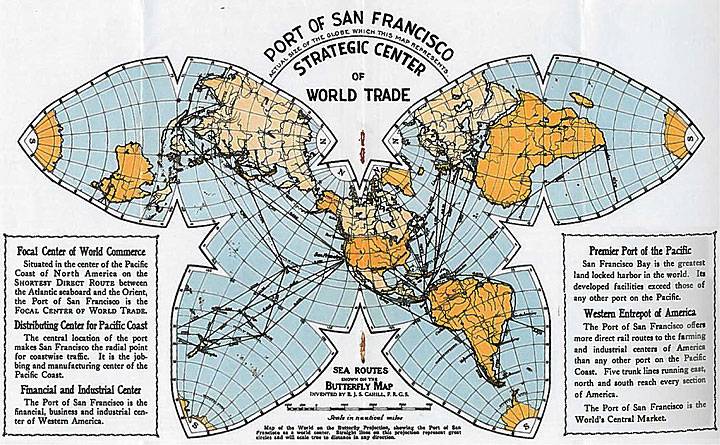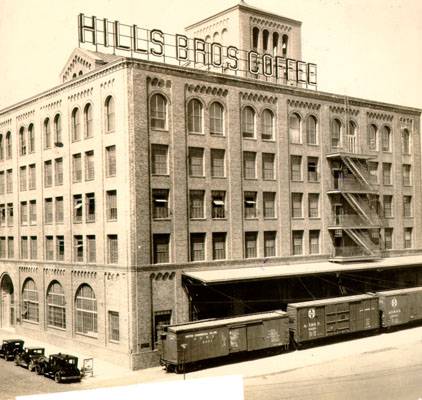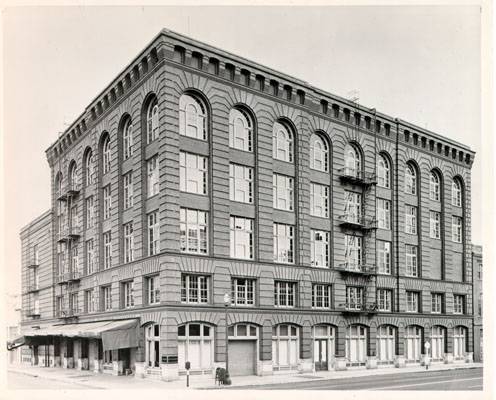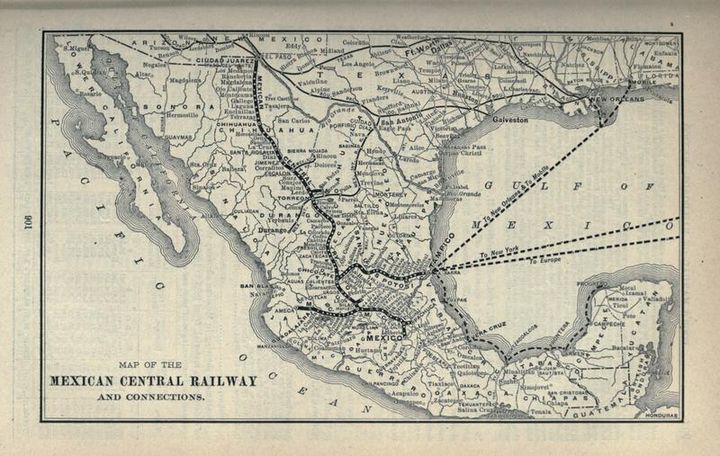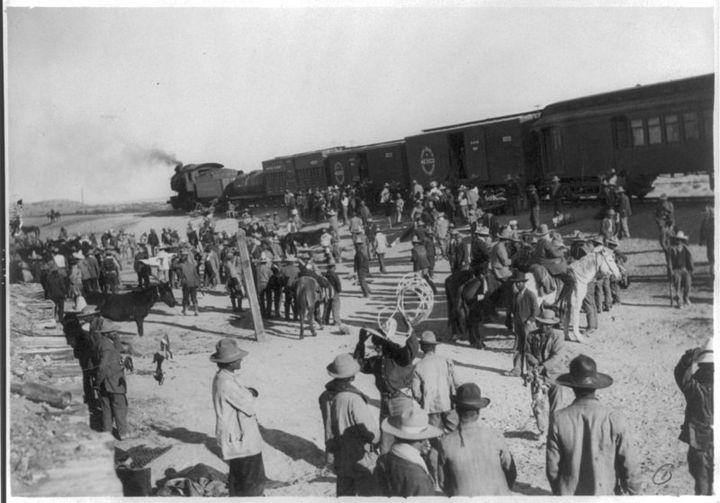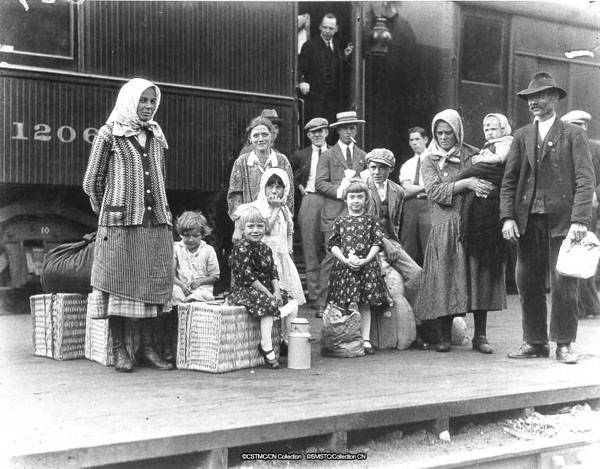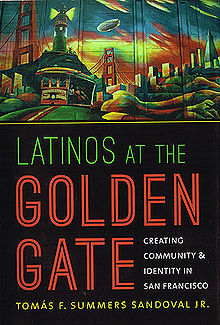Tributary to San Francisco
Historical Essay
by Tomás F. Summers Sandoval Jr.
In late 1906, just months after an earthquake and fire left much of San Francisco in ruins, an article in the San Francisco Chronicle celebrated the completion of multiple railroad lines in northern and western Mexico, “where Californians are opening a rich territory to commerce.” The rail extensions spotlighted in the piece connected the interior of Mexico to the Pacific ports of Guaymas, Acapulco, Mazatlán, and Manzanillo, opening “a territory vastly rich in minerals, hardwoods and tropical and semi-tropical products of all kinds—the most fertile part of all Mexico.” The author praised this development as a monumental advancement for San Francisco’s economic interests. “All this territory is tributary to San Francisco—at its door, with a straight steamer path in between.”(4)
The San Francisco Chamber of Commerce published this map in 1923 to highlight their campaign to put San Francisco at the center of world trade. Indeed, the dense trade routes between San Francisco and Central and South America helped stimulate a steady stream of migration from those areas to the city during the 20th century.
Throughout the twentieth century, the economic connections between San Francisco and distinct parts of Latin America continued to mature and diversify, as U.S. business elites and their concerns benefited from an organized campaign of “peaceful conquest” of the hemisphere.(5)
Largely entailing the “spread of [the United States of] America’s authority through nonmilitary means, through commerce, cultural exchange, and multilateral cooperation,” to significant affect, this deliberate endeavor also utilized armed might toward a “nonterritorial conception of empire.”
As Greg Grandin demonstrates, “by 1930, Washington had sent gunboats into Latin American ports over six thousand times,” in addition to numerous acts of sustained military involvement in Cuba, Honduras, Mexico, and Guatemala, among a host of other nations.(6) In service to its vision of neoimperialism, the United States involved itself in the hemisphere as a “financial trustee,” fostering the “idea that national security, overseas capitalist development, and global democratic reform were indivisible goals.”(7) With U.S. diplomatic and military assets as their willing allies, U.S.-based financial and corporate interests “came to dominate the economies of Mexico, the Caribbean, and Central America, as well as large parts of South America.”(8) As others have shown, the effects of U.S. imperialism in Latin America crippled national economies’ ability to adequately provide for their own citizens, leading to the mass uprooting of rural populations. Dislocated from their homes and traditional forms of sustenance, many of these campesinos migrated to the United States.(9)
Despite the 1906 catastrophe, San Francisco continued to occupy a position of some weight in the flowering U.S. hemispheric empire. In the late nineteenth century San Francisco emerged as “the center of the informal and formal financial networks which spanned the Pacific Coast states.” Few could rival its status, buttressed by isolation and expansive wealth, as the financial center of the West. This position “foreshadowed the city’s emergence as a national center in the twentieth century.”(10) The city’s primacy in the commercial and manufacturing sectors mirrored its position in the financial markets. By early century, the port of San Francisco ranked second only to New York in both the value and volume of its cargo.(11) With berthing facilities unable to fully meet the volume of business—reflected in regular queues of ships in the bay waiting to unload their cargo—it was the leader among the Bay Area’s collection of ports. In 1925 they moved a combined 28.8 million tons of cargo, at a value of more than $1.8 billion.(12)
Likewise, from 1909 to 1925, the value of manufactured products in the city increased by more than 297 percent, to almost $530 million.(13) San Francisco not only provided berth to the ships dominating Pacific trade but also produced ships in the largest shipbuilding plant in the West. Home to glass works and perfume producers and the only chocolate factory on the coast, San Francisco, its Chamber of Commerce boasted, sold “every variety of manufactured article.”(14)
The city was the preeminent economic gateway for the western states, first and foremost California. Beyond the Golden Gate, ships and rails moved California’s goods to market, most notably the fruits and vegetables grown and harvested in the state’s fertile valleys. With their city home to the largest fruit and vegetable cannery in the world as well as to an unrivaled transportation network, San Francisco’s business leaders understood the connection between their metropolis and the state’s agricultural zones. The rest of California, reasoned one Chamber of Commerce publication, “is the back country upon which the city depends—the backbone of the metropolis. The fertile valleys of the Sacramento and the San Joaquin, extending some 600 miles in length, as well as the Napa, Sonoma and Santa Clara valleys, all drain into San Francisco Bay. The products of these valleys are shipped to all parts of the world, from San Francisco. Here the raw materials are manufactured into the finished products. These goods are all handled by San Francisco brokers, commission houses and warehouses.”(15)
San Francisco’s importance to U.S. Pacific trade is clear from the top six international destinations for goods exported through its port in 1914: Japan, England, the Philippine Islands, Australia, Canada, and China.(16) A healthy share of the economic success of the port of San Francisco derived from the U.S. position in Latin America. For example, the United Fruit Company, which exercised an inordinate influence over economic and political institutions in places like Nicaragua, Costa Rica, and Colombia, occupied its own “banana terminal” on Channel Street, moving fruit from refrigerated ships to refrigerated cargo cars. It operated three vessels between Central American ports and San Francisco, transporting both freight and passengers.(17)
Sacks of coffee being lifted from the hold of the Coastal Conqueror, April 20, 1946.
Photo: San Francisco History Center, San Francisco Public Library
San Francisco also witnessed an astronomical increase in coffee importation to its port, making it a national leader in the coffee industry. In the first two decades of the century, San Francisco emerged as “the premier port of the world for Central American coffees,” with a 568 percent increase in the importation of the product.(18) During the period of the First World War, as coffee imports from Brazil dropped and those from Mexico stagnated, a San Francisco—financed and controlled importation of Central American coffee boomed, rising from 40,000 pounds in 1914 to almost 160,000 by war’s end.(19) Celebrating their achievement, groups such as the Green Coffee Association of the San Francisco Chamber of Commerce noted the extent to which their success rested on a merchant-led “bitter fight for supremacy in Central America.” The arrival of almost 1.2 million bags of coffee to port in 1919 represented the culmination of “an uphill struggle for more than forty years” resulting in Central American planters’ being “almost exclusively financed by San Francisco interests.”(20)
Hills Brothers Coffee under Bay Bridge, 1940.
Photo: San Francisco History Center, San Francisco Public Library
Folgers Coffee Company at Howard and Spear, Feb. 3, 1950.
Photo: San Francisco History Center, San Francisco Public Library
City business leaders often looked toward Latin America when planning the city’s future economic growth. In some ways, they viewed San Francisco as part of a larger regional economic zone that included the Pacific ports of the Americas. For example, the Chamber compared the city’s capacity for trade and manufacturing with that of locations not only in the United States but also in Mexico, Central America, and South America.(21)
When local business elites considered the opening of the Panama Canal, they argued that future profits relied on the ability “to fully appreciate what Latin America means to San Francisco and California.”(22) In subsequent years these same interests promoted this perspective in an assortment of ways. Both the English- and Spanish-language press recorded regular “investigative” expeditions by San Francisco businessmen southward with the intent of increasing commerce between the city and the Spanish-speaking nations. In 1921, for example, a delegation of business leaders toured the Mexican west coast in search of trade prospects. Receiving a great deal of notice in the Spanish-language newspaper Centro América, the delegation of Chamber of Commerce members verified that the hostilities of the Revolution had subsided enough to establish new trade ties. Stopping at the major port of Mazatlán, the San Franciscans were welcomed by a Mexican delegation and treated to elaborate ceremonies, fine dining, and a dance in their honor.(23) In the months after their return, and with the help of the major English- and Spanish-language newspapers, they initiated an effort to advertise “the resources and advantages” of San Francisco and “the glories and magnificence” of California. Organized by the Chamber of Commerce, the Real Estate Board, and “many industrial associations,” the campaign included hosting the same sort of events San Franciscans had attended in Latin America.(24)
MJB Coffee at 3rd and Townsend, May 18, 1937, the 3rd of the "big three" San Francisco coffee companies that developed strong relationships with Central and South America.
Photo: San Francisco History Center, San Francisco Public Library
The transnational connections between San Francisco and distinct parts of Latin America were material, long-standing, and continually evolving. At times the context within which developments took root required less an imagination framed by the profit motive than a simple recognition of the realities of life and business in the early twentieth century. For example, as a consequence of their domination of the fruit, oil, and coffee markets, U.S. businessmen and their families spent much of their lives in various parts of Latin America. Not surprisingly, they also began to build institutions there to meet their own health and educational needs. In the twenties, when Anglo-American business elites began fundraising to build a hospital in Guatemala—“for Americans who chance to fall ill while in Guatemala or in neighboring Central American countries”—they naturally sought money from the business community of San Francisco, “whose knowledge of conditions will undoubtedly inspire a quick and generous response.” Rather than “asking for charity in the usual sense of the word,” the fundraising effort was framed as “a friendly start toward helping ourselves.”(25)
For Latin Americans who settled in San Francisco, even those who pursued domestic business ventures without international ties, transnational forces continued to shape family destinies. When a former Guatemalan colonel migrated to the Bay Area and began serving as a corporate official in a local business, he never seemed to envision a life for his San Francisco–born son apart from the Central American nation he once served. When his son was of age, he sent him back to study at his nation’s military academy. The son subsequently returned to the States “for the purpose of getting some active service” and joined the U.S. Army in the war against the Philippines before returning to Guatemala as a colonel in its army.(26)
In the early twentieth century, life in Latin America also reflected many of the forceful interconnections built and maintained by U.S. neoimperialism. Capital from the United States funded the construction of railroads, mining, and systems to extract raw materials like fruit and rubber from Latin America, inciting an internal migration along U.S.-owned networks moving goods from the rural regions of the Southern Hemisphere to U.S. ports. In the case of Mexico, as historian George Sánchez has argued, the dynamics framing Mexican emigration and U.S. immigration are nearly in- separable. “The creation of the Mexican railway system was both a product of and had consequences for not just one, but both sides of the border” as U.S. railroads built during the Porfiriato increased Mexican track from 663 kilometers to more than 19,700.(27) These, in turn, reshaped the demographic distribution of Mexican workers and brought both a rise in rural land values and the widespread loss of traditionally communal holdings.(28)
Mexican Central Railway, early map with connection to U.S. grid at El Paso.
Image: Vanowiki
Mexican railroad during revolution, 1910.
Image: wikipedia
As a general “de-peasanting of the land” occurred, the rails also transformed village life in other ways. Torreón, a village of 2,000 inhabitants in 1876, grew to more than 43,000 by 1910, simply by being at the intersection of the Mexican Central Railroad and the International Railroad. The same sort of growth happened in towns like Nuevo León, Sabinas, and Coahuila.(29) The rails also facilitated the movement of laborers northward to the United States. Most of the migrants to Los Angeles in this same period, for example, originated from towns and villages “within a day’s walk from the railroad lines.”(30) Ports also developed during the Porfiriato, as the nation increased its level of foreign trade “from about 50 million pesos in 1876 to about 488 million pesos in 1910.”(31) Many of the same dynamics marked early-century life in other parts of Central America.
Major improvements to the harbors of Manzanillo, Mazatlán, and Salina Cruz, all located on Mexico’s Pacific coast, further connected Latin America to San Francisco. When Richard Q. Camplis left Acapulco in 1922, he arrived at the Golden Gate via the same shipping lines exchanging com- merce between the two ports. His son remembers that most of the city’s Mexican population then was comprised of “mexicanos de costa,” coastal Mexicans. Their common origin was reflected in the seafood dishes they ate.(32) The majority of Mexican migrants in this era entered the United States through Texas, with about half remaining there permanently. From Texas laborers could also be redistributed to meet urban and rural labor demands throughout the Midwest and West. Approximately 15 percent came to California.(33) When Salvador Sanchez made his initial journey to the United States, first to the Texas border and then to Chicago, he traveled a well-worn path for Mexican migrants, one that not only connected Mexico to the United States but also interconnected North American urban centers in the nexus of industrial capitalism. Sanchez’s further relocation to San Francisco suggests how migrants found themselves at the Golden Gate, even when it was not their initial intended destination.(34)
Mexican immigrants to the U.S., early 20th century.
Image: wikispaces
As a central port in the Pacific empire, San Francisco drew migrant labor as part of a larger network spanning the globe, but always determined by the needs of U.S. business interests. For example, labor contractors like the Alaska Packers’ Association searched for cheap labor throughout the hemisphere. They regularly advertised in the city’s Spanish-language newspapers like Hispano América and ventured southward in their quest. Pedro García, an early-century migrant, recounted how a California-born Mexican “who still shows indigenous features” recruited mexicanos from Sonora and Jalisco to work on Alaska-bound salmon expeditions. Marked by “tortures” and “unequalled deprivations”—the men were virtually imprisoned aboard their fishing ships—his experience at sea filled him with anger “against the foreign exploiters and against one’s own, who in turn abandon out of ignorance the legions of men whose arms are wanted by Mexican fertile soil.” Work as a fisherman in Alaska also entailed regular trips to San Francisco, not only as part of the work route but also as an es- cape from the horrors of the job. As one contemporary phrased it, “When the Mexican laborer starts to lose faith in finding work, he gradually steers himself to San Francisco, where he roams the wharf, famished as a rabid dog fighting over a scrap of bread.”(35)
Alaska Packers Association fleet berthed in Alameda, across from San Francisco.
Image: weeboopiper
Many migrants to San Francisco followed a less direct path, though one still intimately tied to U.S. labor demands. Sam Rios’s father was born in Torreón, Mexico, one of the towns transformed by railroads during the Porfiriato. Rios’s grandmother, who fought in the Revolution, later took her son via the rails and crossed the border at El Paso, Texas. There, the matriarch baptized her child and secured him a birth certificate listing his place of birth as the United States. Rios’s maternal family similarly migrated to El Paso, though their journey originated further south, in the city of Zacatecas. Once in El Paso, the paths of the two families crossed. “Apparently, my mom’s mom and my dad’s mom met each other in El Paso, so they knew each other.”(36) Soon after, his mother’s family headed to Los Angeles where, a decade later, his father’s family arrived. Their paths crossed again, only this time the two teenagers married. The newlyweds found work by following the agricultural circuit throughout California. “From then on, it was nothing more than a trail, from L.A. to Sanger, to Fresno, to Clovis, to Parlier, to, you know, coming up in the camps. . . . So eventually they end up over in the Mountain View area.”(37) Once in the fields around San Jose, his family would eventually move to the area’s largest city—San Francisco. Reflecting the city’s importance to the state’s northern agricultural zones, his mother left her work in the fields and traveled all the way to San Francisco’s Mission Hospital to give birth to her son Sam in 1931.(38)
U.S. business interests also incited labor migration through far more compulsory mechanisms. Along with the growth in San Francisco’s Mexican and Central American populations, the first decades of the century also saw the emergence of a measurable Puerto Rican population in the city. Exported as a source of cheap labor, Puerto Ricans left their island under the direct influence of U.S. sugar interests. Seeking laborers for the cane fields in the U.S. colony of Hawai’i, “recruiters” harvested the dislocated populations in Puerto Rico and sent them to the Pacific on a grueling trip involving sea passage to New Orleans, rail passage to San Francisco, and then another ship voyage halfway across the Pacific.(39) In 1900, more than 50 Puerto Ricans “jumped ship” while in San Francisco. Of the 114 who made the first trip, only 56 arrived in Hawai’i, the rest having engaged in what the press called an “escape.”(40) Their decision also indicates the prospect for integration within the city’s Spanish-speaking enclaves.
San Francisco’s place within the larger hemispheric and national economies translated into opportunities for the highly trained and educated, as well. Spanish-language newspapers that made concerted efforts to foster business ties with the Spanish-speaking hemisphere often featured stories detailing the migration experiences of more prominent individuals and their families, perhaps even encouraging the process. In their telling, these tales often contrasted the stability of the Bay Area to episodic political distress in the Spanish-speaking South. For example, after suffering a “long and distressing trip all over the Central American Republics,” one medical doctor “from a well-known family” permanently settled in San Francisco in 1913.(41) Julio Arce, a publisher of newspapers in Sinaloa and Guadalajara, came in 1915. He had been imprisoned in Mexico in the midst of the Revolution before he used the transnational commercial possibilities extolled in his newspapers and migrated to the Bay Area. He later rose to some prominence in the community.(42) A man known as “General Ruelas” was widely known to have commanded in the Porfirian army before coming to San Francisco in 1914. Within a few years he was a professor of Latin American history at the University of San Francisco. Indeed, local press accounts often contended that “one fairly common émigré [to San Francisco] is the political refugee.”(43)
excerpted from Latinos at the Golden Gate: Creating Community and Identity in San Francisco, by Tomás F. Summers Sandoval Jr., Copyright © 2013 by the University of North Carolina Press. Used by permission of the publisher.

